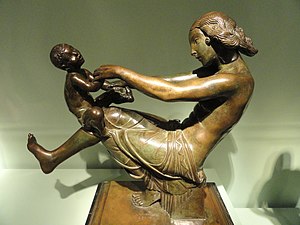
Back لعب (نشاط) Arabic Kawat BCL Kekuri BDR खेल (सामान्य) Bihari খেলা Bengali/Bangla Joc Catalan Káh-dièu CDO Leg Danish Śōg (ativitê) EML Juego (recreación) Spanish

Play is a range of intrinsically motivated activities done for recreation.[1] Play is commonly associated with children and juvenile-level activities, but may be engaged in at any life stage, and among other higher-functioning animals as well, most notably mammals and birds.
Play is often interpreted as frivolous; yet the player can be intently focused on their objective, particularly when play is structured and goal-oriented, as in a game. Accordingly, play can range from relaxed, free-spirited, spontaneous, and frivolous to planned or even compulsive.[2] Play is not just a pastime activity; it has the potential to serve as an important tool in numerous aspects of daily life for adolescents, adults, and cognitively advanced non-human species (such as primates). Not only does play promote and aid in physical development (such as hand-eye coordination), but it also aids in cognitive development and social skills, and can even act as a stepping stone into the world of integration, which can be a very stressful process. Play is something that most children partake in, but the way play is executed is different between cultures, and the way that children engage with play varies.
- ^ Garvey, C. (1990). Play. Cambridge, Mass.: Harvard University Press.
- ^ Huizinga, J. (1980). Homo Ludens: A Study of the Play Element in Culture (PDF) (3rd ed.). London: Routledge & Kegan Paul Ltd. ISBN 978-0-7100-0578-6. Archived from the original (PDF) on 2015-07-01. Retrieved 3 June 2015.